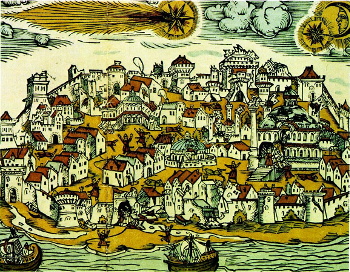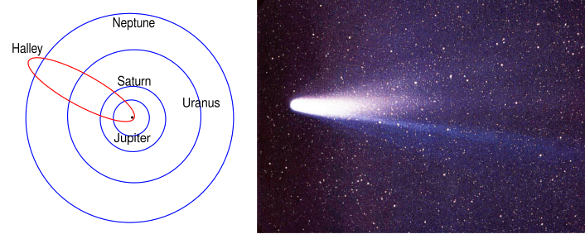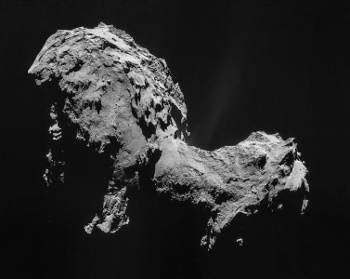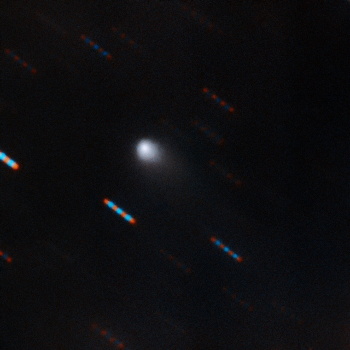Interstellar Comets
October 28, 2019
Humans are
suspicious by nature, and that
trait may have an
evolutionary advantage in protecting us from
danger. The
night sky is generally
regular, so the appearance of a
comet was taken as an
omen; and, by our suspicious nature, these omens were generally bad omens, such as
forecasting the
death of a
monarch or a pending
natural disaster. Note that the
word,
disaster, comes from the
Latin word for
star,
astrum, with the
dis- prefix signifying something bad.

Bad omen in 1556.
A comet appeared on May 5, 1556, and it was followed by an earthquake at Constantinople (present day Istanbul) on May 10, 1556.
The dome of Hagia Sophia was heavily damaged, as were other buildings, and there were many fatalities.
(Colored woodcut by Herman Gall (1554–1580), via Wikimedia Commons image. Click for larger image.)
A few more than 6,000 comets are presently known, but many more are found each year through advances in
astronomical imaging technology. Of these, only about one comet is
visible to the
unaided eye each
year. Comets are thought to originate in the
Oort cloud of small
icy asteroids that surrounds the
Solar System, and there are an estimated 10
12 objects there. The Oort cloud extends from 2,000
au, well beyond the
orbit of
Pluto, to 200,000 au (3.2
light years). Note that the Sun's nearest
stellar neighbor,
Proxima Centauri, is 4.244 light years distant,
A
catalog of comets mentioned in
Greek and
Roman literature before 410
AD appears in ref. 1.[1] The true nature of comets took a while to be discovered.[2-3] Quite
logically,
Aristotle (384 BC-322 BC) thought that comets were
atmospheric phenomena, since they appeared outside the
Zodiac and had a fleeting existence. Aristotle thought that comets were
windy exhalations from the
Earth, and this made their supposed bad affects more believable.[2]
It wasn't until
Tycho Brahe (1546-1601) measured the
parallax of the
Great Comet of 1577 that their true distance from Earth was known. In his 1687
Philosophiae Naturalis Principia Mathematica,
Isaac Newton showed that comets, like other
planetary bodies, obeyed his
inverse square law of
gravity. He showed how the path of the
Great Comet of 1680 was close to a
parabola. A comet following a parabola, however, is not in orbit around the
Sun. Newton speculated that
cometary tails were streams of
vapor ignited by the Sun's
heat, thereby given
luminance.
Of course, the most famous comet is
Halley's Comet. In 1705,
Edmond Halley (1656–1742) used
orbital mechanics to decide that 23 comets sighted from 1337 to 1698 were the same comet, now called Halley's Comet. Based on his
calculations, Halley
predicted that the next appearance of this comet would be in 1758-1759. Other
mathematicians refined Halley's calculations to predict the comet's 1759
perihelion to within a
month's accuracy. Halley's comet is still orbiting the Sun, and its next scheduled appearance is in 2061.

A photograph of the 1986 appearance of Halley's Comet and a diagram of its orbit. (Left image, orbit of Halley's comet among the major planets, modified, by Morgan Phoenix. Right image, a photograph of Halley's comet taken March 8, 1986, by W. Liller at Easter Island as part of the International Halley Watch Large Scale Phenomena Network. Both images from Wikimedia Commons.)
American author and
lecturer,
Samuel Langhorne Clemens (1835-1910), better known by his
pen name, Mark Twain, was born at the 1835 appearance of Halley's comet. Twain
said,
“I came in with Halley's Comet in 1835. It is coming again next year, and I expect to go out with it. It will be the greatest disappointment of my life if I don't go out with Halley's Comet. The Almighty has said, no doubt: "Now here are these two unaccountable freaks; they came in together, they must go out together.”
Twain did, in fact, die at age 74 of a
heart attack on April 21, 1910, a day after the Halley's comet's closest approach to Earth. The true nature of comets was slowly elucidated through observations proving
Fred Whipple's 1950
theory that comets were
dirty snowballs. The
European Space Agency's Giotto probe and the
Soviet Union's Vega 1 and
Vega 2 made close observations of the
coma and
nucleus of Halley's Comet in 1986. In these
flybys, jets of
evaporating material were detected.
To date,
numerous spacecraft have made close observations of many comets, and several have orbited, landed,
sampled, and
impacted comets. The four most significant are listed below.

Comet 67P/Churyumov-Gerasimenko, as imaged by the ESA Rosetta spacecraft.
This is a mosaic of four images.
Comets are so small that they do not have enough mass for gravity to compact their matter into a spherical shape.
(Wikimedia Commons image from the ESA/Rosetta/NAVCAM team.)
Until 2017, all
Solar System objects noted by
astronomers, whether
asteroids or comets, were in orbit around the Sun. On October 19, 2017, an asteroid-like
interstellar object was discovered at an
observatory in
Hawaii. Since it's discovery was from Hawaii, it was given the Hawaiian name,
'Oumuamua. 'Oumuamua has an estimated length of 100-1,000
meters, and an estimated width of 35-167 meters.[4-5]
At its discovery, 'Oumuamua was 0.22 au (33,000,000
kilometers) from Earth, and it was already exiting the Solar System at a speed relative to the Sun that's so high as to certify its
extrasolar origin. ʻOumuamua's
planetary system of origin is not known. Although 'Oumuamua has qualities of an asteroid, not a comet, since it did not have a coma. However, it did show a
non-gravitational acceleration that would indicate gas jetting, a phenomenon of icy comets, so 'Oumuamua might be a remnant of an
exocomet.
One study found that 'Oumuamua passed the nearby star, HIP 17288, about 1.3 Myr ago, and that 2-12 such interstellar objects should visit within an
Earth's orbit of the Sun each year.[4] Another interstellar object may have impacted the Earth in 2014.[5] Analysis of a
meteor detected at 17:05:34 UTC on January 8, 2014, showed that this object had an unbound
hyperbolic orbit with 99.999%
confidence.[5] This meteor of about a half meter in size appeared to have had an
asymptotic speed of about 42.1 ± 5.5
kilometers-per-second outside of the solar system.[5]
Neither 'Oumuamua nor the January 8, 2014, meteor are comets, but on August 30, 2019,
Gennady Borisov, a
Ukrainian amateur astronomer discovered an object with cometary appearance, then designated C/2019 Q4. He made the discovery with a 0.65-meter
telescope that he built himself.[6-8] This comet has been found to be
interstellar in nature, and it's been named
2I/Borisov in honor of its discoverer by the
International Astronomical Union.[7] The
2I in the name is there to indicate that it's the second confirmed interstellar object. Further imaging by larger telescopes revealed a cometary tail and an orbit confirming the object to be interstellar.[6-7]

No, this is not a smudge on your display screen, it's a photograph of interstellar comet 2I/Borisov taken during the night of September 9-10, 2019.
This photograph was taken with the Gemini Multi-Object Spectrograph of the Gemini North Telescope on Hawaii's Mauna Kea.
(Gemini Observatory/NSF/AURA image via the International Astronomical Union.)
The size of comets is difficult to determine, since the small cometary nucleus is embedded in the coma. From
brightness measurements, it's
estimated that 2I/Borisov is from 500 meters to a few kilometers in
diameter.[6-7] The spectrum of 2I/Borisov resembles that of a typical cometary nucleus.[7] 2I/Borisov will reach
perihelion, its closest approach to the Sun, on December 7, 2019.[7] At perihelion, it will be 2 au from both the Sun and Earth. It will be at its brightest in the
southern sky in
December and
January, and it will then leave the Solar System forever.[7] Unlike `Oumuamua, which had a rapid passage, 2I/Borisov will be visible for about a year.[8]
The discovery of 2I/Borisov seems to indicate that interstellar comets might be common, and there might be a sufficient number for study to give insights into the composition of other planetary systems.[6-7] It's interesting that such objects haven't been detected earlier, even with the large number of advanced technology telescopes that we have today.[7]
References:
- A.A. Barrett, "Observations of Comets in Greek and Roman Sources Before A.D. 410," Journal of the Royal Astronomical Society of Canada, vol. 72 (April, 1978), pp. 81-106 (PDF File).
- A History of Comets - Part 1, European Space Agency, September 1, 2019.
- Helmut Hornung, "Cultural history of comets, Max-Planck-Gesellschaft, November 8, 2013.
- Simon Portegies Zwart, Santiago Torres, Inti Pelupessy, Jeroen Bedorf, and Maxwell Cai, "The origin of interstellar asteroidal objects like 1I/2017 U1 'Oumuamua," arXiv, May 11, 2018.
- Amir Siraj and Abraham Loeb, "Discovery of a Meteor of Interstellar Origin," arXiv, June 4, 2019.
- Piotr Guzik, Michał Drahus, Krzysztof Rusek, Wacław Waniak, Giacomo Cannizzaro, and Inés Pastor-Marazuela, "Interstellar comet C/2019 Q4 (Borisov)," arXiv, September 17, 2019.
- Naming of New Interstellar Visitor: 2I/Borisov, International Astronomical Union, Press Release no. 1910, September 24, 2019.
- News at a glance - New Interstellar Visitor Comes, Science, vol, 365, no. 6459 (September 20, 2019), pp. 1226-1227, DOI: 10.1126/science.365.6459.1226 (Paywalled).
Linked Keywords: Human; suspicion (emotion); trait; evolutionary advantage; risk; danger; night sky; uniform; regular; comet; omen; forecast; forecasting; death; monarch; natural disaster; word; disaster; Latin; star; dis-; prefix; May 10, 1556, Constantinople earthquake and comet; earthquake; Constantinople; Istanbul; dome; Hagia Sophia; fatality; woodcut; Wikimedia Commons; astrophotography; astronomical imaging; technology; visual perception; visible; human eye; unaided eye; year; Oort cloud; ice; icy; asteroid; Solar System; astronomical unit; au; orbit; Pluto; light year; star; stellar; Proxima Centauri; astronomical catalog; Ancient Greece; Greek; Roman Empire; Roman; literature; Anno Domini; AD; logic; logically; Aristotle (384 BC-322 BC); atmosphere of Earth; atmospheric; phenomenon; Zodiac; wind; windy; Earth; Tycho Brahe (1546-1601); parallax; Great Comet of 1577; Philosophiae Naturalis Principia Mathematica; Isaac Newton; planet; planetary; inverse square law; gravitation; gravity; Great Comet of 1680; parabola; Sun; cometary tail; vapor; combustion; ignite; heat; luminance; Halley's Comet; Edmond Halley (1656–1742); orbital mechanics; calculation; prediction; predicted; mathematician; apsis; perihelion; month; accuracy; astrophotography; photograph; Morgan Phoenix; Easter Island; International Halley Watch Large Scale Phenomena Network; United States; America; author; lecturer; Mark Twain; Samuel Langhorne Clemens (1835-1910); pen name; God; Almighty; freak; myocardial infarction; heart attack; Fred Whipple; theory; dirt; dirty; snowball; European Space Agency; Giotto (spacecraft); Soviet Union; Vega 1; Vega 2; Coma (cometary); nucleus (cometary); flyby (spaceflight); evaporation; evaporating; material; list of missions to comets; sample (material); impact (mechanics); Stardust (spacecraft); 81P/Wild; Rosetta (spacecraft); 67P/Churyumov-Gerasimenko; orbiter; Philae (spacecraft); Deep Impact (spacecraft)">Deep Impact; 9P/Tempel; mosaic; mass; gravitation; gravity; matter; sphere; spherical; Solar System; astronomer; asteroid; interstellar; observatory; Hawaii; 'Oumuamua; meter; kilometer; extrasolar object; planetary system; non-gravitational acceleration; exocomet; Earth's orbit; meteoroid; meteor; hyperbolic trajectory; hyperbolic orbit; confidence interval; asymptote; asymptotic; kilometers-per-second; Gennady Borisov; Ukraine; Ukrainian; amateur astronomy; amateur astronomer; optical telescope; interstellar comet; 2I/Borisov; International Astronomical Union; display device; display screen; Gemini Multi-Object Spectrograph; Gemini North Telescope; Mauna Kea; brightness; photometry (optics); approximation; estimate; diameter; southern celestial hemisphere; southern sky; December; January.